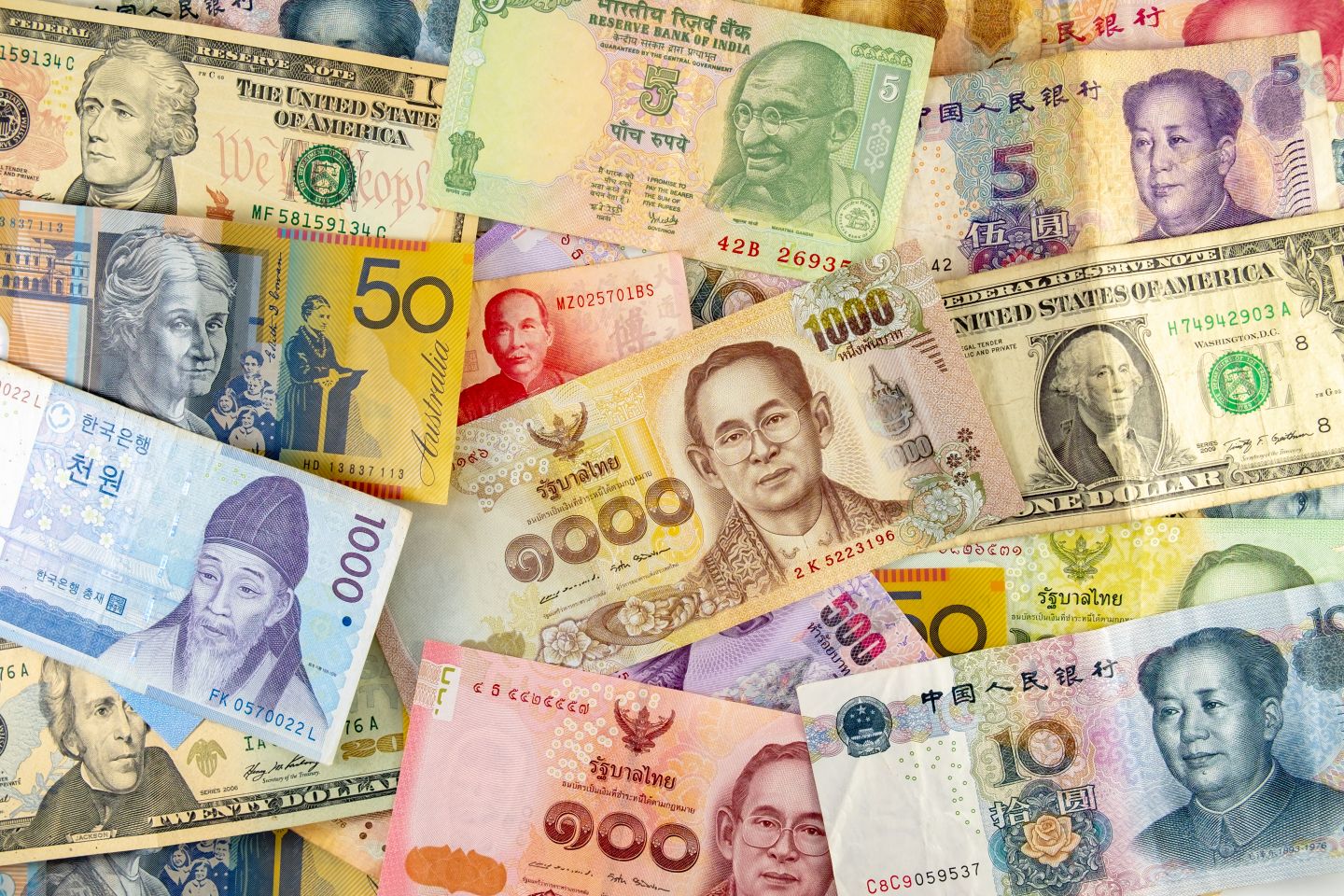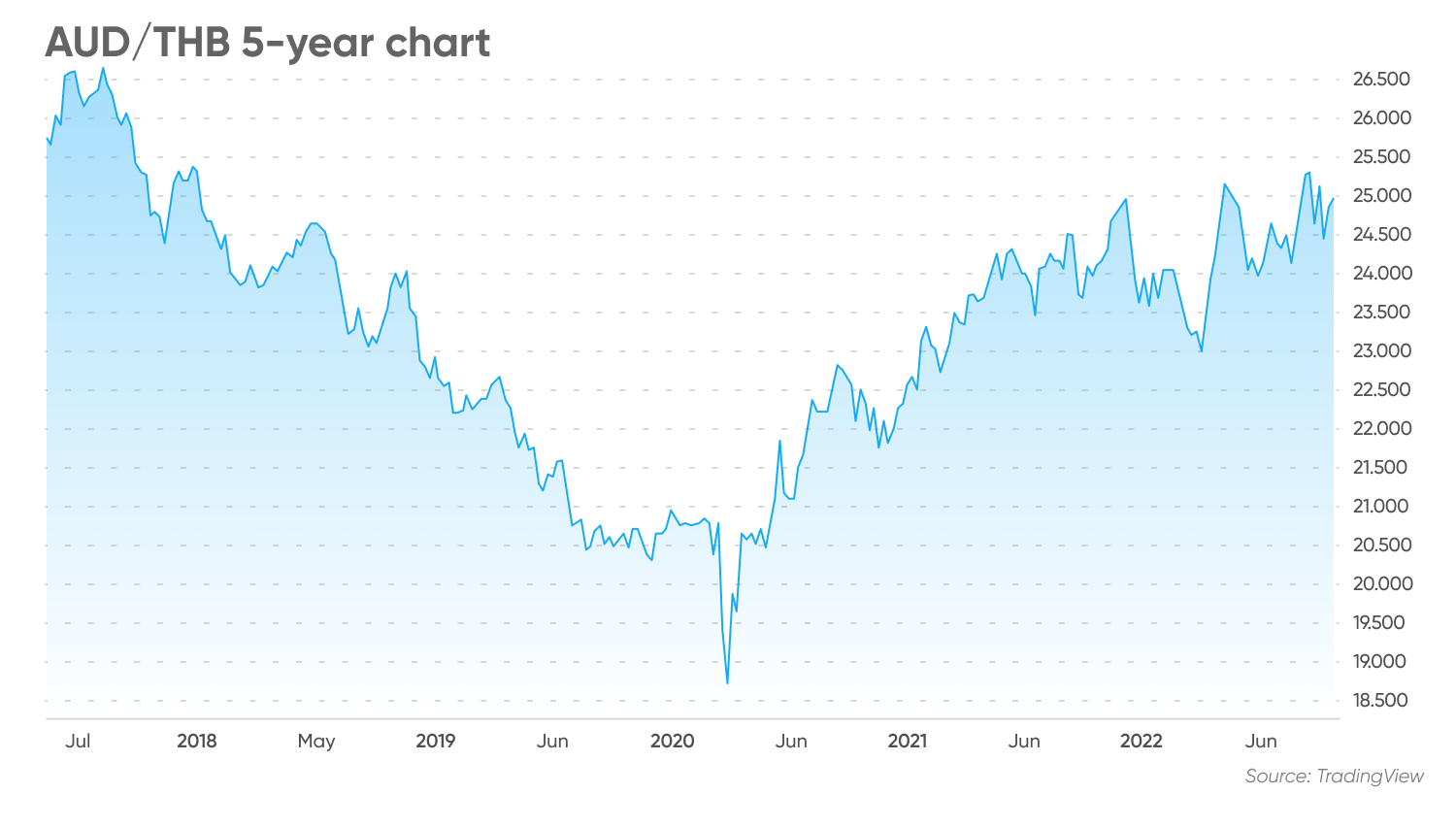AUD/THB forecast: Australian dollar holding on as Thailand bhat surges on tourist boom
Will the Aussie rebound to fresh highs, or retreat further against the THB?
The Australian dollar (AUD) weakened against the Thai baht (THB) in August as the Thai current account balance showed signs of improvement with the government launching promotions to boost a rebound in tourism into 2023 and with crude oil prices retreating from the highs.
Is there scope for the THB – one of the best performing Asian currencies in August – to rise further against the Australian dollar, or are there factors that will support the Aussie relative to the Thai currency? What is a realistic AUD/THB prediction?
In this article, we look at the key drivers for the AUD/THB exchange rate and the latest forecasts from foreign exchange analysts.
What drives the AUD/THB exchange rate?
The AUD/THB pair represents how many Thai baht – the quote currency – are needed to buy one Australian dollar – the base currency.
The Australian dollar, known among currency traders as the ‘Aussie’, is the world’s fifth most traded currency, although Australia’s gross domestic product (GDP) is the 12th largest.
The AUD has an outsized position in the foreign exchange (forex) market, because it’s considered to be a commodity currency, along with the New Zealand dollar (NZD) and Canadian dollar (CAD). This is because the mining industry accounts for 11.5% of the Australian economy and natural resources account for 68.7% of its exports.
The Aussie is often traded as a proxy for investors looking to take a position on the health of the Chinese economy, because China is a major Australian trading partner, accounting for 36.5% of the country’s exports.
The Thai baht is one of the world’s fastest growing currencies and a major currency in southeast Asia, as Thailand has one of the region’s more stable economies, growing manufacturing and agricultural export industries, and a prominent tourism industry. The THB is also influenced by China being one of Thailand’s largest trading partners and a source of tourism.
The Thai baht was pegged to the US dollar for more than a decade until the Asian financial crisis in 1997, when it was floated and quickly fell in value. It partly rebounded over the following years and remains volatile depending on macroeconomic drivers such as GDP growth, current account balances, interest rates, inflation and political events.
AUD/THB volatility reflects monetary policy changes
The Australian dollar has been in a long-term upward trend against the Thai baht since it dropped sharply in March 2020, early in the Covid-19 pandemic.
The AUD/THB pair fell from 20.50 in late February 2020 to 18.90 on 15 March 2020, but then climbed to 22.91 in August as the Aussie benefited from rising commodity prices and Covid-19 infections in China began to fall.
The pair dipped to 21.89 in October 2020, but began to rise again heading into 2021, reaching 23.42 by 3 January.

The AUD/THB rate gradually made gains during 2021, reaching 24.61 at the start of August, when Covid-19 infections in Thailand peaked, and rising further to 25.04 in October, its highest level since 2018.
The pair dropped to 23.05 in February 2022, but rebounded to a fresh five-year high at 25.42 in early April.
The AUD/THB retreated to 24.21 in late April, but rose to 24.71 on 4 May, after the Reserve Bank of Australia (RBA) raised its headline interest rate for the first time since November 2010, from 0.1% to 0.35%, which was above the expected 0.15% increase.
The AUD/THB pair has since been volatile, dropping to 23.82 on 12 May, rising to 24.89 at the start of June, falling to 24.08 two weeks later and then trending up to another five-year high at 25.66 on 27 July.
The pair moved down to 24.58 on 17 August, after the Thai government announced a new tourism push to increase revenues.
The Bank of Thailand (BoT) raised interest rates on 10 August for the first time in three years, hiking it by 25 basis points from a record low of 0.50% to 0.75%.
“Economic recovery has continued to strengthen. The Thai economy is expected to return to the pre-COVID level by the end of this year and will continue to gain traction,” said Piti Disyatat, secretary of the Monetary Policy Committee. “Headline inflation will remain at a high level for some time.”
Disyatat added that “monetary policy normalisation should be done in a gradual and measured manner”.
The RBA is expected to raise rates by another 50 basis points in September to 2.35%, following a 50-basis point rise to 1.85% in August. The rise would be the steepest pace of rate hikes since 1994.
Analysts at Malaysia-based Maybank expect the BoT to raise rates by another 25 basis points in September and again in November, in response to GDP growth, the rise in inflation and to narrow the interest rate differential against the US.
Philip Wee, strategist at Singapore-based DBS, expects the BoT to hold rates unchanged at 0.50% for the rest of the year.
The strength of the Thai baht has drawn the attention of forex traders eyeing a retreat in the value of the US dollar from 20-year highs as a sign to return to investing in emerging markets.
The US Federal Reserve's (Fed) aggressive interest rate hiking policy since March has seen money flowing out of emerging markets, hitting foreign currency reserves and contributing to economic crises in countries such as Sri Lanka, Pakistan and Laos.
In early August, the Thai government said that the country expects to receive 7.5 million tourists in the second half of 2022. That would bring the total for the year to 10 million, up from a forecast of 6.1 million in April, and generate around THB400bn in revenues. The government expects tourism numbers to climb to 30 million in 2023. That’s below the pre-pandemic level of 40 million in 2019 – accounting for around 12% of GDP – but indicating a strong rate of recovery.
The analysts at Maybank wrote:
The AUD/THB pair moved back above the 25.00 mark in the last week of August after China reduced its key lending rates again on 22 August, a week after it surprised markets by cutting two interest rates and a report showed weaker than expected economic growth. The uncertainty surrounding China’s economic outlook had a stronger impact on the baht than the Aussie.
According to an analysis by Bangkok Bank:
Preliminary purchasing manager’s index (PIM) data out of Australia showed that “the employment index slowed but remained in positive territory at 53.2 reflecting the labour supply issues being faced across much of the sector. There was some more encouraging data on service sector prices. The manufacturing PMI remained in positive territory, but dropped slightly from 55.7 to 54.5,” analysts at Dutch bank ING noted.
What do these factors mean for the outlook for the Australian dollar to Thailand baht forecast? Let’s look at some of the latest predictions.
AUD/THB forecast: will the AUD rebound to fresh highs?
“As tourism revenue receipts provide incremental support over time (focus on China Party Congress in Oct for signs of easing in Covid-zero stance), THB drags could ease into 2023,” Maybank analysts noted.
Analysts at Scotiabank noted that if Thailand receives 30 million overseas tourists in 2023 it could “generate a total revenue of about THB 1.5trn. This is expected to improve the nation’s current account balance and prop up the THB.”
DBS strategist Wee noted in the bank's third-quarter FX outlook that “the BOT does not appear overly concerned about THB’s depreciation if it is aligned with regional currency trends and does not deviate from Thailand’s fundamentals.”
The AUD/THB forecast from Trading Economics at the time of writing on 1 September expected the pair to be relatively stable over the next year, trading at 24.7712 by the end of this quarter and at 24.3489 in one year, based on global macro model projections and analysts’ expectations.
Wallet Investor was bullish on the long-term outlook for the Aussie against the Thai baht, predicting that the pair would rise from its AUD/THB forecast for 2022 of 25.1993 at year end to 26.7505 by the end of 2023. The algorithm-based data service’s AUD/THB forecast for 2025 estimated that the pair could trade at 29.7034 by the end of the year. Analysts have yet to issue an AUD/THB forecast for 2030.
If you are interested in trading the AUD/THB pair you should keep in mind that currency markets are highly volatile. We recommend that you always do your own research before making any investment decision based on an AUD/THB forecast. Look at the latest market trends, news, technical and fundamental analysis, and expert opinion and remember that past performance is no guarantee of future returns. And never invest money that you cannot afford to lose.
FAQs
Why has AUD/THB been dropping?
The AUD/THB pair has retreated from five-year highs on expectations of a recovery in Thailand’s tourism sector and lower oil prices supporting the country’s current account.
Will AUD/THB go up or down?
The direction of the AUD/THB pair could depend on, among other factors, monetary policy and economic performance in both countries, as well as trade with China.
When is the best time to trade AUD/THB?
The most active trading time for the AUD/THB market is usually around the release of major macroeconomic data and monetary policy statements or major geopolitical events, which tend to drive volatility on currency markets, increasing liquidity and creating opportunities for traders to profit. However, you should keep in mind that high volatility increases risks of losses.
Is AUD/THB a buy or sell?
Your trading strategy for the AUD/THB pair depends on your risk tolerance, investing strategy and portfolio composition. You should do your own research to develop an informed view of the market. Keep in mind that past performance is no guarantee of future returns. And never invest money you cannot afford to lose.